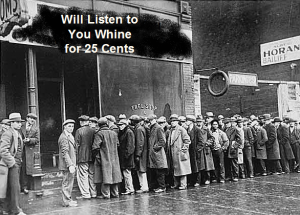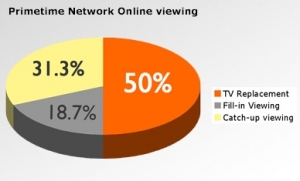 Oh shut up about the stupid recession, you big whiner. I’m sick of hearing about it — and just because it’s an economic depression doesn’t mean we all have to get clinically depressed.
Oh shut up about the stupid recession, you big whiner. I’m sick of hearing about it — and just because it’s an economic depression doesn’t mean we all have to get clinically depressed.
Seriously. You’re beginning to sound like that annoying friend who’s always complaining about health problems… The co-worker or neighbor who doesn’t know that the only right answer to “how are you?” is “fine.”
Yes, online advertising is soft. But here are 10 plus reasons online-video will survive and thrive. Read these because I had to think so hard for some of them that I popped one of my 87 remaining brain cells. The statistics, of course, are 97% made up.
Send these to your boss, customers, clients and peers. Or print them and shove ’em up someone’s profusely pessimistic discard hole. Yeah you heard me.
- The audience is rapidly growing and ads work 41% better better if they reach people.
- The niche content provides better targeting (than 84% of non targeted spending).
- The cost of entry is cheap (unless you piss away $250K on a bunch of “viral video Hail Mary’s” that you post on that micro site… equivalent to a billboard in your basement).
- Amateur creators have huge audiences, and are hungry. They’re also really connected with audiences and influential. Your banner ad isn’t as lucky.
- I like to eat stamp collections but not collectors.
- Video is 93% more visceral and memorable than even rich-media. If I remember your product I’m 29% less likely to forget about it and not buy it.
- I was fooling around with features on my YouTube channel, and decided to make my account invisible because I feel like it. That’s a sidebar.
- Brands will need recession-proof innovation… instead of interruption ads, they’ll partner with creators who already have huge audiences, and get great deals. Add up the top few dozen YouTube stars and you’ll find they get more daily views than many of the media sites combined. Shoot I get around 100,000 viewers a day and I suck the funny right out of the web.
- There is no reason 9 or 13. There’s a 33% chance you won’t notice that because you’re scanning.
- Brand leaders will still want to innovate (73% more than the control, which included that fat guy you work with that twitches out about “process” whenever he hears about change). Grant, they will be 41% more selective than this year and 88% than during The Bubble. So dump the stupid unscalable crap (like another useless Facebook widgets and those pitiful Second Life pilots). They’re like the PR people during layoffs. They’ll be first to go.
- People still need customers or sales tend to go down by 29% or more.
- Because I said so, and I’m a viral video genius. Check Wikipedia if you don’t believe me. There’s a 51% chance you’ve never heard of Wikipedia.


